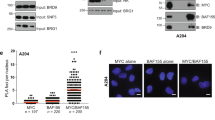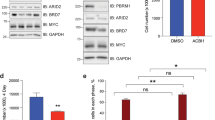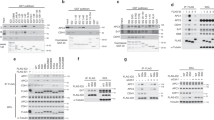Abstract
The forkhead associated (FHA) domain-containing protein Smad nuclear interacting protein 1 (SNIP1) has multiple cellular functions, including the ability to interact with DNA-binding transcription factors and transcriptional coactivators. Moreover, we have demonstrated previously that SNIP1 regulates cyclin D1 expression and promoter activity. Here, we identify a new function for SNIP1 as a regulator of ATR checkpoint kinase-dependent pathways in human U-2 OS osteosarcoma cells: SNIP1 is required for p53 induction in response to ultraviolet light treatment and selectively regulates the phosphorylation of known ATR target proteins, including p53, Chk1 and the histone variant H2AX. These activities are independent of its ability to regulate cyclin D1 expression. Significantly, SNIP1 is also required for ATR-dependent functions of the human p14ARF tumour suppressor, including its ability to modulate the activity of the RelA(p65) NF-κB subunit. This, together with its other described functions, suggests that SNIP1 could have an important role during tumorigenesis and cancer therapy.
This is a preview of subscription content, access via your institution
Access options
Subscribe to this journal
Receive 50 print issues and online access
$259.00 per year
only $5.18 per issue
Buy this article
- Purchase on Springer Link
- Instant access to full article PDF
Prices may be subject to local taxes which are calculated during checkout





Similar content being viewed by others
References
Abraham RT . (2001). Cell cycle checkpoint signaling through the ATM and ATR kinases. Genes Dev 15: 2177–2196.
Bartek J, Lukas J . (2003). Chk1 and Chk2 kinases in checkpoint control and cancer. Cancer Cell 3: 421–429.
Campbell KJ, Rocha S, Perkins ND . (2004). Active repression of antiapoptotic gene expression by ReIA(p65) NF-κB. Mol Cell 13: 853–865.
Chen CL, Edelstein LC, Gelinas C . (2000). The Rel/NF-κB family directly activates expression of the apoptosis inhibitor Bcl-x(L). Mol Cell Biol 20: 2687–2695.
Cortez D, Guntuku S, Qin J, Elledge SJ . (2001). ATR and ATRIP: Partners in checkpoint signaling. Science 294: 1713–1716.
Durocher D, Jackson SP . (2002). The FHA domain. FEBS Lett 513: 58–66.
Durocher D, Taylor IA, Sarbassova D, Haire LF, Westcott SL, Jackson SP et al. (2000). The molecular basis of FHA domain:phosphopeptide binding specificity and implications for phospho-dependent signaling mechanisms. Mol Cell 6: 1169–1182.
Foray N, Marot D, Gabriel A, Randrianarison V, Carr AM, Perricaudet M et al. (2003). A subset of ATM- and ATR-dependent phosphorylation events requires the BRCA1 protein. EMBO J 22: 2860–2871.
Jowsey PA, Doherty AJ, Rouse J . (2004). Human PTIP facilitates ATM-mediated activation of p53 and promotes cellular resistance to ionizing radiation. J Biol Chem 279: 55562–55569.
Kim RH, Flanders KC, Reffey SB, Anderson LA, Duckett CS, Perkins ND et al. (2001). SNIP1 inhibits NF-κB signaling by competing for its binding to the C/H1 domain of CBP/p300 transcriptional co-activators. J Biol Chem 276: 46297–46304.
Kim RH, Wang D, Tsang M, Martin J, Huff C, de Caestecker MP et al. (2000). A novel Smad nuclear interacting protein, SNIP1, suppresses p300-dependent TGF-β signal transduction. Genes Dev 14: 1605–1616.
Li J, Williams BL, Haire LF, Goldberg M, Wilker E, Durocher D et al. (2002). Structural and functional versatility of the FHA domain in DNA-damage signaling by the tumor suppressor kinase Chk2. Mol Cell 9: 1045–1054.
Liao H, Byeon IJ, Tsai MD . (1999). Structure and function of a new phosphopeptide-binding domain containing the FHA2 of Rad53. J Mol Biol 294: 1041–1049.
Lin WC, Lin FT, Nevins JR . (2001). Selective induction of E2F1 in response to DNA damage, mediated by ATM-dependent phosphorylation. Genes Dev 15: 1833–1844.
Lowndes NF, Toh GW . (2005). DNA repair: the importance of phosphorylating histone H2AX. Curr Biol 15: R99–R102.
Motoyama N, Naka K . (2004). DNA damage tumor suppressor genes and genomic instability. Curr Opin Gene Dev 14: 11–16.
Redon C, Pilch D, Rogakou E, Sedelnikova O, Newrock K, Bonner W . (2002). Histone H2A variants H2AX and H2AZ. Curr Opin Gene Dev 12: 162–169.
Rocha S, Campbell KJ, Perkins ND . (2003a). p53- and Mdm2-independent repression of NF-κB transactivation by the ARF tumor suppressor. Mol Cell 12: 15–25.
Rocha S, Garrett MD, Campbell KJ, Schumm K, Perkins ND . (2005). Regulation of NF-κB and p53 through activation of ATR and Chk1 by the ARF tumour suppressor. EMBO J 24: 1157–1169.
Rocha S, Martin AM, Meek DW, Perkins ND . (2003b). p53 Represses cyclin D1 transcription through down regulation of Bcl-3 and inducing increased association of the p52 NF-κB subunit with histone deacetylase 1. Mol Cell Biol 23: 4713–4727.
Roche KC, Wiechens N, Owen-Hughes T, Perkins ND . (2004). The FHA domain protein SNIP1 is a regulator of the cell cycle and cyclin D1 expression. Oncogene 23: 8185–8195.
Stiff T, Reis C, Alderton GK, Woodbine L, O'Driscoll M, Jeggo PA . (2005). Nbs1 is required for ATR-dependent phosphorylation events. EMBO J 24: 199–208.
Stott FJ, Bates S, James MC, McConnell BB, Starborg M, Brookes S et al (1998). The alternative product from the human CDKN2A locus, p14(ARF), participates in a regulatory feedback loop with p53 and MDM2. EMBO J 17: 5001–5014.
Syljuasen RG, Sorensen CS, Hansen LT, Fugger K, Lundin C, Johansson F et al. (2005). Inhibition of human Chk1 causes increased initiation of DNA replication, phosphorylation of ATR targets, and DNA breakage. Mol Cell Biol 25: 3553–3562.
Wang Y, Qin J . (2003). MSH2 and ATR form a signaling module and regulate two branches of the damage response to DNA methylation. Proc Natl Acad Sci USA 100: 15387–15392.
Acknowledgements
We are grateful to Dr Anita Roberts for her help, assistance and encouragement to investigate SNIP1. She will be greatly missed. We thank Dr Kirsteen Campbell who prepared the SNIP1 monoclonal antibodies used in this study, Katie Schumm for characterization of the cyclin D1 siRNA, Dr Kostya Panov for providing gel filtration protein samples and Dr John Rouse for helpful discussions. KCR was funded by the Association of International Cancer Research (AICR) and SR and CPB are funded by a programme grant from Cancer Research UK (C1443/A5435). Additional funding was received from the Royal Society.
Author information
Authors and Affiliations
Corresponding author
Additional information
Supplementary Information accompanies the paper on the Oncogene website (http://www.nature.com/onc).
Supplementary information
Rights and permissions
About this article
Cite this article
Roche, K., Rocha, S., Bracken, C. et al. Regulation of ATR-dependent pathways by the FHA domain containing protein SNIP1. Oncogene 26, 4523–4530 (2007). https://doi.org/10.1038/sj.onc.1210233
Received:
Revised:
Accepted:
Published:
Issue Date:
DOI: https://doi.org/10.1038/sj.onc.1210233
Keywords
This article is cited by
-
MKRN1 promotes colorectal cancer metastasis by activating the TGF-β signalling pathway through SNIP1 protein degradation
Journal of Experimental & Clinical Cancer Research (2023)
-
Dynamic analysis of DNA damage induced miRNAs in colon cancer cells
Chinese Science Bulletin (2014)
-
ATR: an essential regulator of genome integrity
Nature Reviews Molecular Cell Biology (2008)



